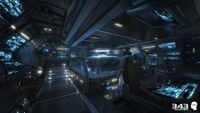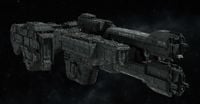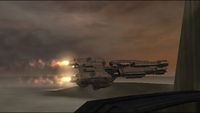Stalwart-class light frigate
From Halopedia, the Halo wiki
| Stalwart-class | |||||||||||||||||||||||||||||||||
|---|---|---|---|---|---|---|---|---|---|---|---|---|---|---|---|---|---|---|---|---|---|---|---|---|---|---|---|---|---|---|---|---|---|

| |||||||||||||||||||||||||||||||||
| Class attributes | |||||||||||||||||||||||||||||||||
|
Identification: |
|||||||||||||||||||||||||||||||||
|
Operators: |
|||||||||||||||||||||||||||||||||
|
Manufacturer: |
|||||||||||||||||||||||||||||||||
|
In service: |
|||||||||||||||||||||||||||||||||
| |||||||||||||||||||||||||||||||||
The Stalwart-class light frigate is an escort ship type in service with the UNSC Navy. Manufactured by SinoViet Heavy Machinery, these frigates are designated with the hull code FFG.[2] The Stalwart class are used primarily in fleet escort duties, providing screens for larger capital ships.[4] Designed with planetary defense in mind, Stalwart frigates have proven successful due to their superb balance between fleet support and troop transportation.[5]
Overview[edit]

Design details[edit]
The Stalwart-class light frigate is one of the smaller classes of frigate in service with the UNSC Navy, and the smallest used during the Human-Covenant War.[3] At 478 meters in length with a mass of 0.93 million metric tons, the ship only outmasses the post-war Anlace-class and Mulsanne-class light frigates.[2][3] The ship's overall profile is of a style that would later become standardised in its sister Charon-class and Paris-classes, featuring a skeletal form, a two-pronged bow and an aft section containing engines inside armoured wing pods. The upper hull boom contains the fire control systems and pulsed power storage for the ship's primary weapon; the Magnetic Accelerator Cannon, while the lower boom contains the weapon itself. This is in stark contrast to the Charon and Paris-classes, which both fit the weapon in the upper boom. The upper boom is also fitted with panels of Active Phased Array Radars for guidance and target tracking.[2]
The port and starboard sides of the main hull are each fitted with a hangar pod capable of storing the ship's complement of dropships and vehicles. The hangars launch their craft via a small hatch underneath the hangar, which a given ship must be loaded down into. Each hangar can launch or recieve one dropship at a time. The ventral mast of the ship contains the ship's drop pod deployment bay, consisting of a magazine-fed coilgun accelerator to get the pods up to speed when conducting planetary assault missions. Above the ship is mounted the bridge, which contains its own life support that will function even if the rest of the ship is crippled.[2]
Extremely mobile,[4] the Stalwart was built for acceleration and sustained high-thrust manevuers during naval engagements.[3] the Stalwart class is outfitted with two OKB Karman 56K fusion drives for sublight travel. The Stalwart is equipped with a Starwerx FTL-290C, a slipspace drive featuring a Series IV CODEN field generator.[2]
Crew and complement[edit]
A Stalwart-class light frigate is crewed by 250 sailors. In addition, these frigates also carry a complement of 200 Marines and a company of 64 Orbital Drop Shock Troopers. However, the frigate only carries twenty-four M8823 Human Entry Vehicles. The ODSTs that are deployed from the frigate via an SOEIV drop pod are launched from the ship by a magazine-fed coilgun accelerator.[2]
While Stalwart frigates lack the larger hangar bays seen on the Charon-class light frigate,[8] the class is outfitted with six hangar modules, each capable of launching or recovering only a single dropship at a time. These frigates typically carry six D77 Pelicans as well as their associated support equipment,[2] with some Stalwarts also carrying D96 Albatrosses.[7] The class also carries twelve M12 Warthogs and six M808 Scorpion tanks.[2]
Armaments[edit]
Well-armed for a frigate,[4] the Stalwart-class light frigate is equipped with a single 56A2D4 Mark II light Magnetic Accelerator Cannon, serving as the primary armament of the class. The upper boom of the frigate contains the fire control systems and pulsed power storage for the MAC, which is fitted in the lower boom.[2] A rapid-fire variant of the frigate's MAC system is installed on Epoch-class heavy carriers.[9]
For secondary armaments,[6] Stalwart frigates are fitted with 16 anti-ship M58 Archer missile pods, as well as 76 long-range anti-fighter M340A4 Streak missile pods.[2] These frigates are armed with a point defense gun network mounted along the hull for tertiary armaments,[6] consisting of six M870 Rampart point defense guns and fifty-two M710 Bulwark point defense guns.[2]
Usage[edit]
The Stalwart is considered a remarkably effective vessel for space warfare, something credited to the design's resilience[3] and leading it to become one of the most prominent frigate classes in UNSC service during the Human-Covenant War.[4] It is primarily designed for planetary defence missions, with the goal of balancing troop deployment and fleet escort capabilities[4][5] - a role it shares with the Charon-class frigate, albeit with more a focus on point-defence to the Charon's focus on troop capacity.
Ships of the line[edit]
- UNSC In Amber Clad (FFG-142)
- UNSC Meriwether Lewis
- UNSC Midsummer Night (FFG-209)
- UNSC Stalwart Dawn (FFG-4471)
Operational history[edit]
Designed by distinguished naval engineer David Pulver and Doctor Eugene Taylor,[2] the Stalwart-class light frigate was one of the most prominent classes of frigate in service with the UNSC Navy during the Human-Covenant War.[4] In service by 2515,[3] several Stalwart frigates were a part of Admiral Preston Cole's Third Fleet towards the end of the Harvest campaign.[10]
On February 9, 2547, sixteen Stalwart-class light frigates finished their final assembly together at SinoViet Naval Yard AS-9 over Reach, the youngest of which was UNSC In Amber Clad. After two years of service, all fifteen of In Amber Clad's sister ships were destroyed fighting lost battles during the Siege of Paris IV, the attack on Iota, and the Fall of Arcadia. Receiving partial repairs and replenishment at Tribute, In Amber Clad was assigned to Lieutenant Commander Miranda Keyes on April 7, 2550,[2] with the frigate being reassigned to the Sol system's Home Fleet.[1]
Numerous Stalwart-class frigates was prominently seen in orbital use against Covenant fleets during the Battle of Sigma Octanus IV and Fall of Reach.[11][12] At some point before the Battle of Line Installation 1-4, at least two Stalwart-class vessels were shot down by the defenses of Line Installation 1-4 and crashed into the moon along with several other starships.[13] The In Amber Clad was in dock with Cairo Station above Earth on October 20, 2552 when the Covenant Fleet of Sacred Consecration found and assaulted the planet. Commander Keyes immediately assembled her crew for battle, intending to assist the rest of the fleet. During the opening actions of the engagement, Fleet Admiral Joseph Harper led the Fifth Fleet, which included a force of sixty-seven Stalwart-class vessels in defending Earth. Presumably many of these frigates were destroyed over the course of the battle before eventually succeeding in disabling the shields of the Syfon-pattern assault carrier Day of Jubilation, prompting Keyes to renew her assault on In Amber Clad. However, Spartan-II supersoldier John-117 intervened and destroyed the carrier before this could happen, and the Master Chief regrouped with In Amber Clad to reinforce UNSC forces defending against the Covenant in New Mombasa. The In Amber Clad sent its Marines and ODSTs to aid the Chief in reaching the second carrier Solemn Penance, from which the Prophet of Regret was leading the ground action. After routing the Covenant ground forces, the In Amber Clad pursued the Solemn Penance into slipspace, leading to the discovery of Installation 05 on November 2, 2552.
The In Amber Clad again deployed her ground forces led by the Master Chief to track down and kill the Prophet of Regret before he attempted to activate Halo, triggering the Battle of Installation 05. Through the course of the campaign, the In Amber Clad continued to harass Covenant operations on the ringworld's surface, leading to the Prophet's eventual assassination by the Master Chief. With the outbreak of the Flood, In Amber Clad was captured and its surviving crew assimilated, the vessel itself forced to perform a slipspace jump inside the Covenant holy city High Charity to unleash the growing horde upon its inhabitants. In Amber Clad was rendered inoperable following this action as the survivors battled against both the Covenant and the Flood.
Post-war service[edit]
Stalwart-class frigates continued to serve in the UNSC Navy after the War's end. Prior to October 2558, the UNSC Meriwether Lewis hosted a Spartan contingent, with Spartan Edward Buck acting their commander until he was reassigned to Fireteam Osiris aboard the UNSC Infinity.[14]
Non-canon and dubious canon appearances[edit]
Silver Timeline[edit]
- Main article: Silver Timeline
| This article contains information about the Silver Timeline, and is not a part of the established Halo canon. |
Stalwart-class frigates are used by the UNSC Navy at WHITE TOWER.[15] One ship of the class, the UNSC Stalwart Dawn, would pursue a rogue John-117.[16] Stalwart-class frigates would also later participate at a battle over a Halo ring.[17]
Production notes[edit]

|
Browse more images in this article's gallery page. |
The idea of multiple distinct frigate classes was not something formalised in Halo canon until the release of Halo: The Essential Visual Guide in 2011. Prior to this, UNSC frigates were treated largely as visual variations on the same concept. In Rob Stokes' first draft script for Halo 3, the frigates UNSC Forward Unto Dawn, UNSC Madrid, UNSC Ningbo, and UNSC Ophir are all referred to as Stalwarts - something which carries over to the in-game filenames for Forward Unto Dawn and UNSC Aegis Fate's models. This also carried over into Halo: Reach, with the Paris frigate internal filenames retaining the Stalwart moniker - something reflected in portfolio renders released by artist Matt Turner.[18]
The ship was originally concepted by Eddie Smith for Halo 2's production, and variations on its design can be seen in the storyboards released by Lee Wilson. Since its formalisation as a distinct vessel, the Stalwart has been given two major redesign treatments; one by Blur Studio for the Halo 2: Anniversary VFX cutscenes, with the model created by Davide Di Giannantonio, and another by Ajai John for RocketScience VFX for Halo: The Television Series. The TV Stalwart frigate displays a number of notable differences from the Blur model.
Gallery[edit]
Illustrations[edit]
A Stalwart-class frigate with the UNSC Spirit of Fire in Halo Wars: Genesis.
Stalwart-class frigates of the Battle Group Leviathan battle the Second Fleet of Solemn Accord over Sigma Octanus IV.
Multiple Stalwart-class frigates of the Epsilon Eridani Fleet engage the combined Covenant fleet over Reach.
Halo Wars 3 concept art depicting a Stalwart in space combat.
Halo: The Television Series Season Two concept art depicting a Stalwart deploying D20 Herons onto a Halo installation.
Renders[edit]
Render of In Amber Clad for Halo 2: Anniversary.
Promotional render of the redesigned Stalwart in Halo: The Television Series.
Screenshots[edit]
The Stalwart-class frigate In Amber Clad in Halo 2.
In Amber Clad over New Mombasa.
The profile of a Stalwart-class frigate, dwarfed by a CAS-class assault carrier.
A Stalwart deploys its complement of HEVs piloted by Orbital Drop Shock Troopers onto Installation 05.
A Stalwart-class frigate with a Paris-class heavy frigate in Halo Mythos.
List of appearances[edit]
|
Sources[edit]
- ^ a b c d Halo: The Essential Visual Guide, page 98
- ^ a b c d e f g h i j k l m n o p q r s t u v w x y z aa ab ac ad ae af ag ah ai Halo: Warfleet, page 36-37
- ^ a b c d e f g h i j k l m n o Halo Encyclopedia (2022 edition), page 122
- ^ a b c d e f g h Halo: The Essential Visual Guide, page 76
- ^ a b c Halo Waypoint, UNSC Frigate (Retrieved on Apr 6, 2017) [archive]
- ^ a b c d e Halo Waypoint, UNSC In Amber Clad (Retrieved on Nov 29, 2015) [archive]
- ^ a b Halo Waypoint, Delta Halo (Retrieved on Oct 27, 2015) [archive]
- ^ Halo: The Essential Visual Guide, page 74
- ^ Halo: Warfleet, page 40
- ^ Halo Wars: Genesis
- ^ Halo: Fall of Reach - Covenant
- ^ Halo: Fall of Reach - Invasion
- ^ Halo: Blood Line, issue 1
- ^ Halo 5: Guardians Limited Edition, Dossier files - Jameson Locke
- ^ YouTube - Paramount+, Halo The Series (2022) Official Trailer (Retrieved on Jan 30, 2022)
- ^ Halo: The Television Series, episode Unbound
- ^ Halo: The Television Series, episode Halo
- ^ Matt Turner's blog, matt-turner-reach-frigate.jpg (Retrieved on Oct 15, 2014) [archive]
| ||||||||||||||||||||||||||||||||||||||||||||||||||||||||





















